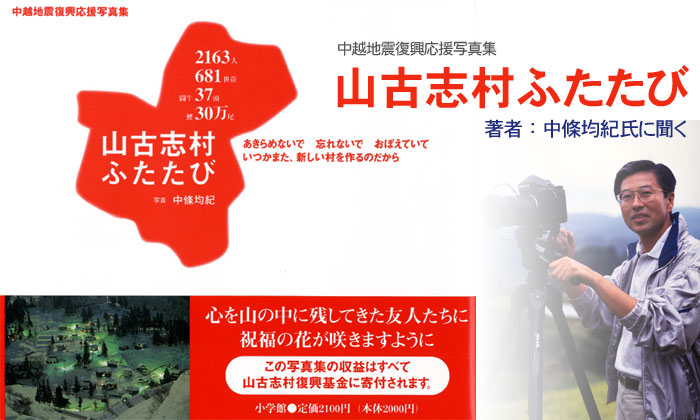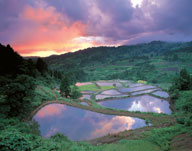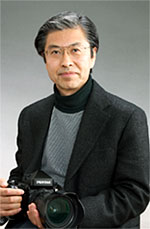 |
| “Yamakoshi-mura Futatabi” (Reminiscences of Yamakoshi Village) is published by Shogakukan Inc. |
|
“Yamakoshi-mura Futatabi” (Reminiscences of Yamakoshi Village), a photo album published 4 months after the Niigata Earthquake, is attracting a great deal of interest. This photo album is a record of the pre-quake Yamakoshi Village’s beautiful scenery and hard-working villagers; it reflects the history and traditional culture inherited by their forefathers. It also reminded many Japanese of their gentle and warm-spirited Japanese. With help from the author, Mr. Nakajo, and the publisher, Shogakukan, INPC is making an English version of this photo album. We took this occasion to talk directly with Mr. Nakajo. (interviewed on July 16, 2005) |
| How did you get started as a photographer? |
|
Nakajo
 I was born in Sanjo City, Niigata Pref in 1952. I didnft pursue a career as a photographer when I was young. I started taking pictures because I wanted to keep a record of my childfs growth. After that, I acquired photographing techniques by myself. I used to travel to many places and took many pictures, but I didnft like any of them. When you really want to take good scenic pictures, the photo spot has to be somewhere nearby. So I chose Yamakoshi Village which is close to my home and decided to devote all my energies to taking pictures of Yamakoshi. That was in 1987. I was born in Sanjo City, Niigata Pref in 1952. I didnft pursue a career as a photographer when I was young. I started taking pictures because I wanted to keep a record of my childfs growth. After that, I acquired photographing techniques by myself. I used to travel to many places and took many pictures, but I didnft like any of them. When you really want to take good scenic pictures, the photo spot has to be somewhere nearby. So I chose Yamakoshi Village which is close to my home and decided to devote all my energies to taking pictures of Yamakoshi. That was in 1987. When I say scenery, I mean nature, people and their daily lives. I had to find a place near by my living area to take a true scenic picture. And for me, that was Yamakoshi. I always chose concepts when taking pictures. In 1990, I held my first photo exhibition The Seasonal Traditions of the Three Echigo Mountains.In 1999, I held another exhibition The Home of Koshi and also published a photo album at the same time. In 2004, I held the The Home of Koshi II, and once again published a photo album. Sofve been taking pictures like that, keeping my job at a company as well |
| Can you tell us once again why you keep shooting Yamakoshi? |
| Nakajo I currently live in Nagaoka City, and go to many places to take pictures, but I’m just not satisfied with them. I chose Yamakoshi because I can get there in about 30 minutes. If the spot is too far, I have less chances of capturing a good photo moment. Photography is a split-second opportunity, so to get it, I have to go to that spot many times, understand that spot, and have to wait. I can take good pictures only after having visited the same spot over and over again and only if I can predict the changes affected by the season or time. I want to use my own legs to get there; I don’t want other people to tell me good photo spots, and I don’t like for people to guide me. After observing the spot myself, I really start understanding, or in other words, predicting. And as I walk around, I find “my spot” and visit it dozens of times. Otherwise, you can’t take really good pictures. |
| Have you ever though of becoming a professional photographer? |
| Nakajo No,fve never thought of that. A professional photographer has to take pictures, whether you like it or not, because itfs a job. In my case, I donft have to take any pictures if I donft feel like it, so I canft ask for more. Yes, I have received various awards, and I have gotten offers to become a professional photographer. But I think it is a question of way of living, and I donft intend to change my way of doing things. Thatfs why I donft want to become professional. |
| When I look at your pictures, I feel a sense of craftsmanship. |
| Nakajo I feel funny when called a craftsman. I consider myself to be a techie. Accumulation of data is important in taking pictures. To express the light, you need to know if exposure should be +1, +0.5 or -0.5; you have to be able to choose the condition of the light that you want for your picture. Itfs a mixture of sensibility and technique, which means even if you have abundant sensibility, if you donft have the techniques to express it, you canft take good pictures. And vice versa. And of course, you always have the unpredictable factor which is what makes it interesting. A picture that you thought was terrible might turn out to be great. Once again, vice versa. |
| I heard that you teach photograph classes. What do you consider important when you teach photography? |
| Nakajo How to enjoy it. I teach my students how to take pictures while enjoying it. I donft teach them how to take pictures that can win awards. Everybody has different sensibility, so I want people to know that there are various techniques in expressing themselves in a picture. |
| Have you gone to the site after the earthquake to take pictures? |
| Nakajo Ifve been there 4 times already. I went there once before winter, and 3 times in spring. The situation there has become worse in spring. There were avalanches, and the houses have been destroyed by all the snow. I have taken pictures before and after the earthquake, but sincefm not a media photographer, I keep shooting without changing my approach. I believe in the power of reconstruction, of people, and of nature, and I simply keep taking pictures of those scenes. |
| Especially after the earthquake, you probably have been receiving many requests for photo exhibitions. |
| Nakajo Yes, youfre right.fve been asked to hold exhibitions not only in Japan but in the U.S. as well. I have pictures, but the question is operating costs. I think there are several ways of doing it. We can sell photo albums, and if that covers the operating costs, and on top of that, if it becomes profitable, we can pass it on the Yamakoshi Village. Although I canft predict how the Americans will perceive these sceneries,fd like to take advantage of those opportunities and to receive as much voices from as many people. But the important point is that something should be passed on to Yamakoshi; I donft want an exhibition just for myself. Itfs great that Nishikigoi lovers feel interest in Yamakoshi and that they sense something from my pictures, but I donf want my pictures to be all bells and whistles. I want them to feel the power Yamakoshifs nature and people posses from my pictures, so I want to create many opportunities for many people to see them. |
| Thank you for your time today. We look forward to seeing more of your excellent pictures. |
|
|
 Masanori Nakajo
Masanori Nakajo